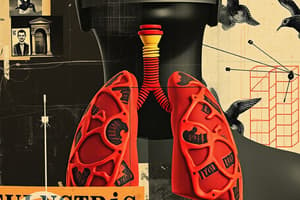Podcast
Questions and Answers
What is the primary characteristic of carbon monoxide in relation to its physical properties?
What is the primary characteristic of carbon monoxide in relation to its physical properties?
- It is a heavy gas with a distinct taste.
- It is a colorless, odorless, tasteless gas. (correct)
- It is a colored, pungent gas.
- It is a highly irritating gas.
How does carbon monoxide affect hemoglobin in the blood?
How does carbon monoxide affect hemoglobin in the blood?
- It increases the dissociation of oxygen from hemoglobin.
- It enhances oxygen binding to hemoglobin.
- It prevents hemoglobin from transporting any gases.
- It has a binding affinity 250 times greater than that of oxygen. (correct)
What effect does carbon monoxide have on the hemoglobin-oxygen dissociation curve?
What effect does carbon monoxide have on the hemoglobin-oxygen dissociation curve?
- It has no effect on the curve.
- It causes the curve to flatten.
- It shifts the curve to the right.
- It shifts the curve to the left. (correct)
What is a common source of carbon monoxide production?
What is a common source of carbon monoxide production?
Which of the following statements about carbon monoxide is false?
Which of the following statements about carbon monoxide is false?
Flashcards are hidden until you start studying
Study Notes
Characteristics of Carbon Monoxide
- Colorless, odorless, and tasteless gas that is nonirritating.
- Binds to hemoglobin, forming carboxyhemoglobin with a binding affinity 250 times greater than oxygen.
- Interferes with the hemoglobin-oxygen dissociation curve by shifting it to the left, reducing oxygen transport.
Source of Carbon Monoxide
- Produced from incomplete combustion of carbon-containing materials.
- Occurs in environments with insufficient oxygen availability.
- Typically generated in very small amounts under normal conditions.
Studying That Suits You
Use AI to generate personalized quizzes and flashcards to suit your learning preferences.




